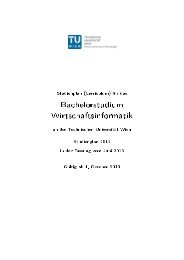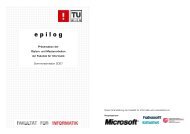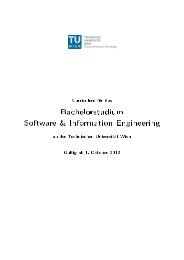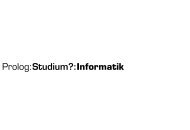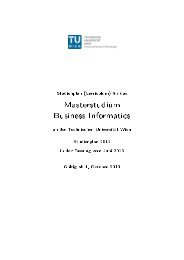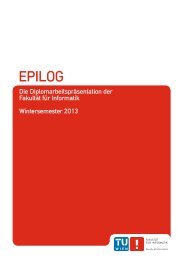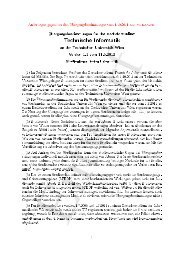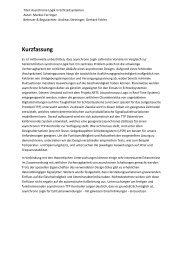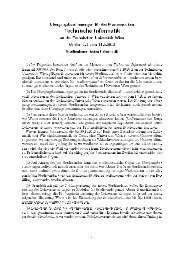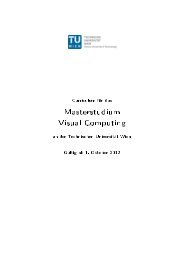Abstract-Band - Fakultät für Informatik, TU Wien - Technische ...
Abstract-Band - Fakultät für Informatik, TU Wien - Technische ...
Abstract-Band - Fakultät für Informatik, TU Wien - Technische ...
Erfolgreiche ePaper selbst erstellen
Machen Sie aus Ihren PDF Publikationen ein blätterbares Flipbook mit unserer einzigartigen Google optimierten e-Paper Software.
Arbeitsbereich Business Informatics<br />
Thomas Halmetschlager<br />
Interactive Modeling for the Eclipse Modeling Framework<br />
Studium: Masterstudium Medizinische <strong>Informatik</strong><br />
Betreuerin: O.Univ.Prof. Dr. Gertrude Kappel<br />
The high complexity of modern software makes it unavoidable to develop<br />
software with the help of graphical, model based editors. Software models<br />
serve not only as documentation or as a rough system overview. They are<br />
also the fundament to generate a executable system. The larger the<br />
application the more persons are involved in the design and development<br />
process. Simultaneous changes on a model are very common. With these<br />
concurrent changes conflicts can occur. There is a need of interpersonal<br />
communication to solve appearing questions and avoid misunderstandings.<br />
Specially in the early stage of software development diversities in<br />
interpretation can occur easily because the semantics of models can be<br />
interpreted different. To avoid such problems the communication channels<br />
within the team should be supported as much as possible. With good<br />
communication it should be possible to conclude a consolidated solution of<br />
the problem in a collaborative way. Within this thesis ways and means are<br />
sought to enable interactive model-driven software development with the<br />
Eclipse Modeling Framework. It turned out that there are already several<br />
approach for this interactive development method. These budding<br />
candidates where reviewed and analyzed. Unfortunately each of the tested<br />
systems had some disadvantages or they were not mainly designed for<br />
model-driven software development. When the analysis of various existing<br />
approaches was finished, a list of requirements was created. The search for a<br />
tool that matches the requirements as good as possible and that can be<br />
extended easily was started and finished with an acceptable result. Therefore<br />
the implementation part consists of a extension of a existing tool. The chosen<br />
tool is CDO, Connected Data Objects, a plugin for Eclipse. CDO was selected<br />
because it is the best match to our requirements. We think we found the<br />
optimal candidate to develop a sustainable solution.<br />
Tanja Mayerhofer<br />
Breathing New Life into Models - An Interpreter-Based Approach for Executing<br />
UML Models<br />
Studium: Masterstudium Wirtschaftsinformatik<br />
Betreuerin: O.Univ.Prof. Dr. Gertrude Kappel<br />
12<br />
Over the past years Model-Driven Development (MDD) gained significant<br />
popularity. With the usage of this paradigm the software engineering process<br />
becomes more model-centric, i.e., models become the main artifact and<br />
therewith the whole software development process relies on these models



